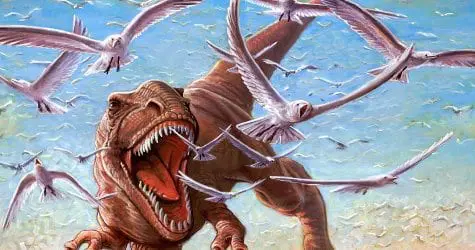[Originally published as Avian vs Dinosaurian Cranial Kinesis]
Evolutionary apologists have believed and taught until very recently that the modern avian trait of palatine kinesis (movable or mobile beak) is a post-Cretaceous development following the K-Pg mass extinction event. During the transition from “non-avian” to “avian” in the evolutionary tale of dinosaur-to-bird evolution, the dinosaurian trait of a fixed palate was lost, giving rise to palatal mobility (mobile beak) by acquiring the trait of a pterygoid/palatine joint.
Extant birds with this trait are classified in the infraclass of Neognaths. In contrast, most large, flightless birds (e.g., ratites) retain a much more rigid jaw that does not allow for palatal kinesis due to the fusing of the pterygoid and palatine joint, which prohibits medial articulation. These birds are classified in the infraclass of Paleognaths. The evolutionary belief is these birds either never lost this inherited dinosaurian trait, or at some point, reverted back to it.
As explained by ScienceDaily:
For more than a century, it had been assumed that the mechanism enabling a mobile beak evolved after the extinction of the dinosaurs… Each of the roughly 11,000 species of birds on Earth today is classified into one of two over-arching groups, based on the arrangement of their palate bones… The two groups were originally classified by Thomas Huxley, the British biologist known as ‘Darwin’s Bulldog’ for his vocal support of Charles Darwin’s theory of evolution. In 1867, he divided all living birds into either the ‘ancient’ [Paleognaths] or ‘modern’ [Neognaths] jaw groups. Huxley’s assumption was that the ‘ancient’ jaw configuration was the original condition for modern birds, with the ‘modern’ jaw arising later.
What, precisely, was the scientific support for this belief?
“This assumption has been taken as a given ever since,” said Dr. Daniel Field from Cambridge’s Department of Earth Sciences, the paper’s senior author. “The main reason this assumption has lasted is that we haven’t had any well-preserved fossil bird palates from the period when modern birds originated.”
The absence of evidence was their evidence!
Unfortunately for this belief’s adherents, the analysis of a bird specimen named Janavis finalidens by the University of Cambridge and the Natuurhistorisch Museum Maastricht has completely dismantled this evolutionary teaching. As their paper in the Journal Nature states:
Neognaths exhibit unfused palate bones and generally kinetic skulls, whereas palaeognaths possess comparatively rigid skulls with the pterygoid and palatine fused into a single element, a condition long considered ancestral for crown birds (Neornithes). However, fossil evidence of palatal remains from taxa close to the origin of Neornithes is scarce, hindering strong inferences regarding the ancestral condition of the neornithine palate. Here we report a new taxon of toothed Late Cretaceous ornithurine bearing a pterygoid that is remarkably similar to those of the extant neognath clade Galloanserae (waterfowl + landfowl)… We recovered Janavis as the first-known well-represented member of Ichthyornithes other than Ichthyornis, clearly substantiating the persistence of the clade into the latest Cretaceous. Janavis confirms the presence of an anatomically neognathous palate in at least some Mesozoic non-crown ornithurines… Our results, combined with recent evidence on the ichthyornithine palatine, overturn longstanding assumptions about the ancestral crown bird palate, and should prompt reevaluation of the purported galloanseran affinities of several bizarre early Cenozoic groups such as the ‘pseudotoothed birds’ (Pelagornithidae).
No known dinosaur skull has been identified with palatine kinesis. They all have a fixed, rigid palate. Other varieties of cranial kinesis have been suggested, such as streptostyly, which is simply movement along the jaw hinge of the quadrate in such dinosaurs as Carnotaurus and Allosaurus, as well as metakinesis where a possible amount of movement could take place between the dermatocranium (skull roof) and the chondrocranium (braincase) in dinosaurs such as Dromaeosaurus.
Additionally, hadrosaurid ornithopods have been shown to have skulls with pleurokinesis – multiple jointing providing multiple points of movement, resulting in a “near-vertical posterodorsal power stroke during feeding; near-vertical jaw opening; and propalinal movements in near anterior and near posterior directions.”
Previously, the intramandibular joint between the dentary and postdentary bones of theropod dinosaurs was believed to provide kinesis similar to that of snakes. It is now believed the joint served more to absorb stress, working with the prearticular bone at the rear of the jaw to keep the joint rigid.
The significant conclusion gained from these studies is the observational reality that palatine kinesis is strictly a non-dinosaurian trait. Based on all available data, the presence of such a trait in a fossil would most certainly eliminate a dinosaurian identification.
Additionally, the most recent discovery of palatine kinesis in a Cretaceous rock layer has caused significant problems for the established narrative of avian evolution, demanding, once again, a rewriting of the evolutionary mythos by evolutionary apologists. Conversely, the biblical creationist model of created kinds is unremittingly supported by observational science.






